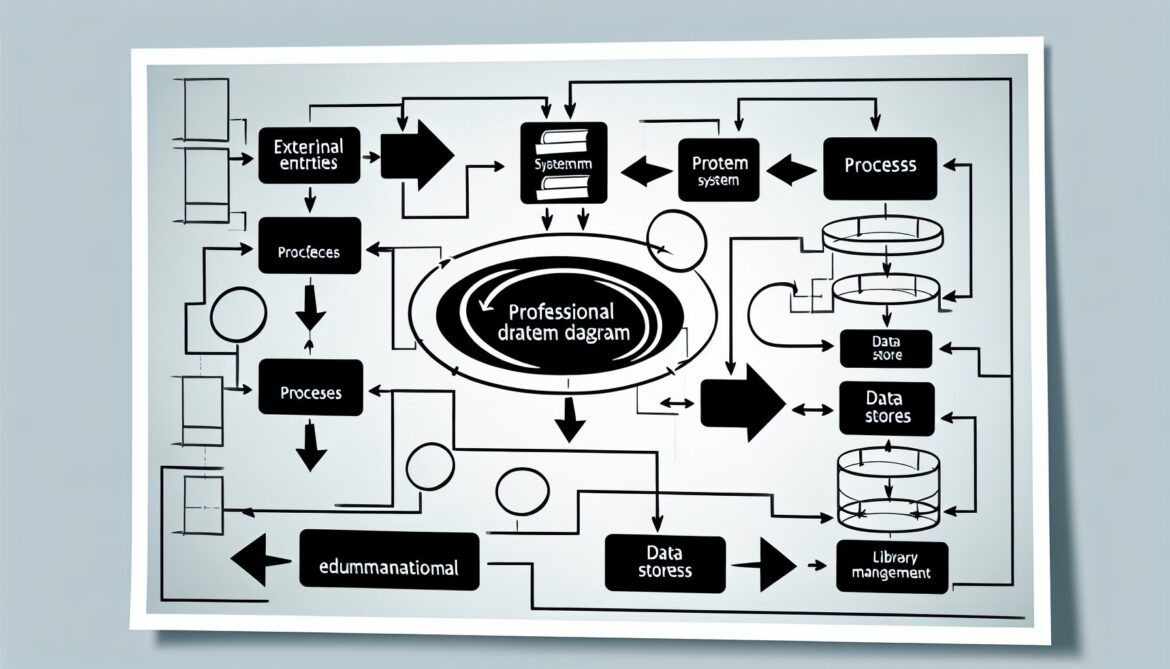Data Flow Diagrams (DFDs) are fundamental tools in software engineering and systems analysis that visualize how data moves through a system. Unlike flowcharts that show program flow, DFDs focus specifically on data transformation and storage, making them essential for understanding complex systems, documenting business processes, and communicating system designs to both technical and non-technical stakeholders.
In today’s data-driven applications and microservices architectures, understanding data flow is more critical than ever. DFDs help developers, analysts, and project managers visualize system boundaries, identify bottlenecks, and ensure all data processing requirements are captured and documented.
Understanding DFD Components and Notation
Data Flow Diagrams use four primary symbols to represent different system elements:
- External Entities (Rectangles): People, organizations, or systems outside your system boundary that provide data to or receive data from your system
- Processes (Circles/Ovals): Activities that transform incoming data into outgoing data
- Data Stores (Open Rectangles): Repositories where data is stored, such as databases, files, or memory structures
- Data Flows (Arrows): Paths along which data travels, labeled with descriptive names
DFD Symbol Standards
Here’s a visual representation of standard DFD notation:
flowchart TD
A[External Entity<br/>Customer] --> B((Process 1.0<br/>Validate Order))
B --> C[(D1: Orders Database)]
B --> D[External Entity<br/>Payment System]
C --> E((Process 2.0<br/>Generate Report))
E --> F[(D2: Reports Archive)]
classDef external fill:#e1f5fe,stroke:#01579b,stroke-width:2px
classDef process fill:#e8f5e8,stroke:#2e7d32,stroke-width:2px
classDef datastore fill:#f3e5f5,stroke:#7b1fa2,stroke-width:2px
class A,D external
class B,E process
class C,F datastoreDFD Levels and Hierarchical Decomposition
Context Diagram (Level 0)
The context diagram provides the highest-level view of your system, showing the system as a single process with its external entities and major data flows. This diagram establishes system boundaries and scope.
flowchart TD
A[Customer] --> B((E-Commerce System))
C[Payment Provider] --> B
D[Supplier] --> B
B --> A
B --> C
B --> D
B --> E[Shipping Company]
classDef system fill:#ffeb3b,stroke:#f57f17,stroke-width:4px
classDef external fill:#e1f5fe,stroke:#01579b,stroke-width:2px
class B system
class A,C,D,E externalLevel 1 DFD
Level 1 decomposes the context diagram into major processes, showing how the main system functions interact with each other and with external entities.
flowchart TD
A[Customer] --> B((1.0<br/>Process Order))
B --> C[(D1: Customer Database)]
B --> D((2.0<br/>Manage Inventory))
D --> E[(D2: Product Database)]
B --> F((3.0<br/>Process Payment))
F --> G[Payment Provider]
F --> H[(D3: Transaction Log)]
B --> I((4.0<br/>Arrange Shipping))
I --> J[Shipping Company]
C --> B
E --> D
H --> F
classDef external fill:#e1f5fe,stroke:#01579b,stroke-width:2px
classDef process fill:#e8f5e8,stroke:#2e7d32,stroke-width:2px
classDef datastore fill:#f3e5f5,stroke:#7b1fa2,stroke-width:2px
class A,G,J external
class B,D,F,I process
class C,E,H datastoreLevel 2 and Beyond
Each process in Level 1 can be further decomposed into Level 2 DFDs, showing more detailed sub-processes. This hierarchical approach continues until you reach primitive processes that cannot be meaningfully decomposed further.
Real-World Example: Library Management System
Let’s walk through creating a complete DFD for a library management system to demonstrate practical application.
Context Diagram
flowchart TD
A[Library Member] --> B((Library Management<br/>System))
C[Librarian] --> B
D[Publisher] --> B
B --> A
B --> C
B --> D
classDef system fill:#4caf50,stroke:#1b5e20,stroke-width:4px
classDef external fill:#e3f2fd,stroke:#0d47a1,stroke-width:2px
class B system
class A,C,D external
Level 1 Decomposition
flowchart TD
A[Library Member] --> B((1.0<br/>Manage<br/>Membership))
A --> C((2.0<br/>Search & Reserve<br/>Books))
A --> D((3.0<br/>Borrow & Return<br/>Books))
E[Librarian] --> B
E --> F((4.0<br/>Catalog<br/>Management))
E --> G((5.0<br/>Generate<br/>Reports))
H[Publisher] --> F
B --> I[(D1: Members)]
C --> J[(D2: Book Catalog)]
D --> K[(D3: Transactions)]
F --> J
G --> L[(D4: Reports)]
I --> B
J --> C
K --> D
J --> F
classDef external fill:#e3f2fd,stroke:#0d47a1,stroke-width:2px
classDef process fill:#c8e6c9,stroke:#2e7d32,stroke-width:2px
classDef datastore fill:#f8bbd9,stroke:#ad1457,stroke-width:2px
class A,E,H external
class B,C,D,F,G process
class I,J,K,L datastoreDFD Construction Best Practices
Balancing Rule
One of the most important DFD principles is balancing: all data flows entering or leaving a process at one level must be accounted for at the next level of decomposition. This ensures consistency and completeness across different levels of detail.
Naming Conventions
- Processes: Use active verbs (e.g., “Validate User,” “Generate Report,” “Update Inventory”)
- Data Flows: Use noun phrases describing the data (e.g., “Customer Details,” “Order Status,” “Payment Confirmation”)
- Data Stores: Use descriptive names with “D” prefix (e.g., “D1: Customer Database,” “D2: Product Catalog”)
- External Entities: Use names of actual people, organizations, or systems
Common Mistakes to Avoid
- Showing control flow instead of data flow: DFDs show data transformation, not program control
- Including physical implementation details: Focus on what data flows, not how it’s implemented
- Mixing levels of detail: Keep each DFD level consistently detailed
- Forgetting to balance: Ensure data flows are consistent across levels
- Using unclear labels: All flows and processes should be clearly named
Modern Applications of DFDs
Microservices Architecture Documentation
In modern microservices architectures, DFDs help visualize data flow between services, identify service boundaries, and document API interactions.
flowchart TD
A[Mobile App] --> B((API Gateway))
C[Web App] --> B
B --> D((User Service))
B --> E((Order Service))
B --> F((Payment Service))
B --> G((Notification Service))
D --> H[(D1: User Database)]
E --> I[(D2: Order Database)]
F --> J[(D3: Payment Database)]
G --> K[(D4: Message Queue)]
E --> F
F --> G
classDef external fill:#e1f5fe,stroke:#01579b,stroke-width:2px
classDef gateway fill:#fff3e0,stroke:#e65100,stroke-width:3px
classDef service fill:#e8f5e8,stroke:#2e7d32,stroke-width:2px
classDef datastore fill:#f3e5f5,stroke:#7b1fa2,stroke-width:2px
class A,C external
class B gateway
class D,E,F,G service
class H,I,J,K datastoreData Pipeline Design
DFDs are excellent for documenting ETL processes, data warehousing workflows, and analytics pipelines, helping teams understand complex data transformations.
flowchart LR
A[Data Sources] --> B((Extract))
B --> C[(Raw Data Store)]
C --> D((Transform))
D --> E[(Staging Area)]
E --> F((Load))
F --> G[(Data Warehouse)]
G --> H((Analytics))
H --> I[Reports & Dashboards]
classDef source fill:#e1f5fe,stroke:#01579b,stroke-width:2px
classDef process fill:#e8f5e8,stroke:#2e7d32,stroke-width:2px
classDef storage fill:#f3e5f5,stroke:#7b1fa2,stroke-width:2px
classDef output fill:#fff3e0,stroke:#e65100,stroke-width:2px
class A source
class B,D,F,H process
class C,E,G storage
class I outputBusiness Process Analysis
Business analysts use DFDs to model current state processes, identify inefficiencies, and design improved future state processes.
Tools and Technologies for DFD Creation
Popular DFD Tools
- Lucidchart: Cloud-based with excellent collaboration features and DFD templates
- Draw.io (now Diagrams.net): Free, web-based tool with extensive DFD symbol libraries
- Microsoft Visio: Professional diagramming with advanced DFD stencils
- Creately: Intuitive interface with real-time collaboration
- Mermaid: Text-based diagrams that can be version controlled (as used in this article)
Integration with Development Workflow
Modern development teams integrate DFDs into their workflow by:
- Version Control: Storing DFD source files (like Mermaid) in Git repositories
- Documentation as Code: Including DFDs in automated documentation generation
- Code Generation: Using DFDs to generate API skeletons and database schemas
- Testing: Creating test scenarios based on DFD data flows
DFD Analysis Techniques
Process Analysis
Analyze each process in your DFD to identify:
- Complexity: Processes with many inputs/outputs may need decomposition
- Performance bottlenecks: Processes handling large data volumes
- Error handling: Missing error flows or exception handling
- Security concerns: Processes handling sensitive data
Data Store Analysis
Examine data stores for:
- Access patterns: Frequently accessed data stores may need optimization
- Data consistency: Multiple processes updating the same data store
- Storage requirements: Data stores with high growth rates
- Backup and recovery: Critical data stores needing protection
Advanced DFD Concepts
Temporal Aspects
While traditional DFDs are static, modern systems often require temporal considerations:
- Event-driven flows: Data flows triggered by specific events
- Batch vs. real-time: Different processing modes for the same data
- Seasonal variations: Data volumes that change based on business cycles
Security and Compliance
Modern DFDs should incorporate security considerations:
- Data classification: Mark sensitive data flows
- Access controls: Document who can access what data
- Audit trails: Show logging and monitoring data flows
- Regulatory compliance: GDPR, HIPAA, SOX data handling requirements
DFD Review and Validation Checklist
Use this checklist to ensure your DFDs are complete and accurate:
Completeness Check
- All external entities identified and included
- All data stores accessed by at least one process
- All processes have both input and output data flows
- All data flows are clearly labeled
- System boundary is clearly defined
Consistency Check
- DFD levels are properly balanced
- Process numbering follows conventions
- No orphaned processes or data stores
- Data flow names are consistent across levels
- No control flows mixed with data flows
Quality Check
- Diagram is readable and well-organized
- Process names use active verbs
- Data flow names are descriptive nouns
- Appropriate level of detail for audience
- No unnecessary complexity
Conclusion and Best Practices Summary
Data Flow Diagrams remain one of the most effective tools for understanding and communicating system designs. They bridge the gap between business requirements and technical implementation, providing a common language for stakeholders across different disciplines.
Key takeaways for effective DFD creation:
- Start simple: Begin with a context diagram and progressively add detail
- Focus on data: Show data transformation, not program control
- Maintain consistency: Follow naming conventions and balancing rules
- Iterate and refine: DFDs improve through review and revision
- Use appropriate tools: Choose tools that support collaboration and version control
- Keep them current: Update DFDs as systems evolve
Whether you’re designing a new system, documenting an existing one, or analyzing business processes for improvement opportunities, mastering DFD techniques will enhance your ability to understand, communicate, and improve complex systems.
Remember that DFDs are living documents—they should evolve with your system and continue to provide value throughout the software development lifecycle. Regular reviews and updates ensure they remain accurate and useful for both current team members and future maintainers of your systems.








One thought on “Data Flow Diagram ( DFD )”